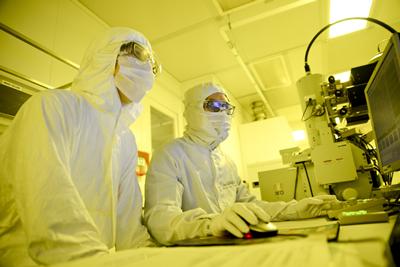Novel thin film approach published to help improve future memory and energy harvesting devices

Scientists at the University of Southampton have developed a molecular reagent for a highly functional chemical compound used in phase change memory units and thermoelectric generators.
The chemical reagent can deposit thin films of germanium telluride (GeTe) with high purity and good functional properties, making it attractive for future technological applications.
Findings from the collaborative research, which has included expertise from the Schools of Chemistry and Electronics and Computer Science (ECS), has been published in Dalton Transactions.
The scientists’ method devised a single source reagent containing both the germanium and tellurium atoms required for the target GeTe material, bypassing the conventional need for compatible substances for each element where the molar ratio can be more difficult to control.
“GeTe is a very useful material so we are pleased to have made this significant advance,” Research Fellow Dr Ruomeng Huang explains. “This provides us with the potential of applying these films into functional devices to produce better performance. Our next step will be to conduct thorough functional characterisation of the deposited GeTe thin films and benchmark them with the state-of-art performance.”
The GeTe compound is often used in the field of phase change memory, a non-volatile memory technique used in place of flash memory in electronic devices. It can also be found in thermoelectric generators, an energy harvesting technique that coverts waste heat into electricity.
The work continued a long-standing collaboration between the Functional Inorganic, Materials and Supramolecular Chemistry group, led by Professor Gill Reid, and the Sustainable Electronics Technologies group in ECS, led by Professor Kees De Groot.
Further to the current work on GeTe, the interdisciplinary team has developed a range of other functional semiconducting materials such as SnSe2, Bi2Te3, Sb2Te3 and jointly authored over 10 publications in international journals.
Previous projects have demonstrated molecular reagents with unique behaviours during deposition, such as selectively growing materials onto specific areas on a patterned substrate. “These areas can be in dimensions from hundreds of micrometres to tens of nanometres,” Ruomeng explains. “This unique selective deposition behaviour will greatly simplify the fabrication process for any functional device and if a similar behaviour can be achieved using our GeTe reagent it will represent another important breakthrough.”
Several specialist research facilities were used during this latest project including multinuclear NMR spectroscopy, X-ray diffraction, Raman spectroscopy, scanning electron microscopy and energy dispersive X-ray analysis. The substrates for the deposition were fabricated in the University’s state-of-art Southampton Nanofabrication Centre.
Scientists also collaborated with Dr Gavin Stenning and Dr Marek Jura from the ISIS Neutron and Muon Source at the Rutherford Appleton Laboratory in Oxford, operated by the Science and Technology Facilities Council (STFC).